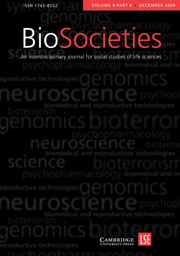It is impossible to understand the nature of the contemporary life sciences and biomedicine, or the interventions into living processes that are now possible, without appreciating the role of capitalization. It has only become possible to understand and modulate living processes at the molecular level because of the investment of capital, over long periods, in training of personnel, establishing laboratories, procuring equipment and material, translating from lab bench to bedside or market, managing intellectual property rights and much more. To point to this centrality of capitalization—whether from public, philanthropic or private sources—is not to critique the knowledge produced, or to imply that it is inescapably profit driven, or that the purity of science is tainted by association with money. But it is to recognize that there are intrinsic interdependencies between bioscience and biocapital in our developing biosocieties, dependencies whose nature and implications need to be charted and evaluated.
Investment, however public spirited, is made in the expectation of a return, whether that be in shareholder value, the economic and social value of individual and collective health, the improvement of public welfare or the elimination of global inequities. Decisions as to where to invest resources are shaped by many desires and anticipations. They are often grounded in unspoken presuppositions about the kinds of human beings we are, individually and collectively, and about the kinds of lives to which we should aspire. In a path-dependent world, such commitments are not merely an ethical overlay to the business of discovery and invention: they actually shape the knowledges that we have of living beings, and the things we are able to do to ourselves, to others, to ‘nature’ in the name of human well-being.
The papers in this issue all contribute, in different ways, to our understanding of key dimensions of this bioeconomy, its diversity, its imperatives and its consequences. Generalized critiques of the commodification of nature are inadequate to analyse contemporary imaginaries and practices that seek to unlock the untapped biovalue stored in life, whether that be in the uncharted oceans (Helmreich) or within the human body (Hoeyer). Analyses of the economics and bioethics of health care and its regulation that confine themselves to national contexts are outflanked by the emergence of a global market for health, where the mobility of knowledges and capital is being accompanied by the mobilization of sick bodies and biomedical technologies in the name of health and wealth (Turner). Sweeping critiques of potential genetic discrimination on economic grounds fail to understand the particular economics of markets for insurance products and their ways of dealing with imperfect knowledge about human predispositions (Mittra). And indeed, the idea of an emergent bioeconomy to capture the latent value in living processes, such as that developed in Europe by the Organisation for Economic Co-operation and Development, is not simply a description of an empirical field, but plays a key role in inventing this field, and in shaping the hopes and fears, the anticipatory technologies, the policies and regulations, that are constituting it (Hilgartner, Parry). In this rapidly changing context, the capacities of social scientists to understand and intervene in these developments are also shaped by decisions about research funding priorities: research funding priorities will be fundamental to our capacity to take responsibility for our future biosocieties (Novotny).
Once more, the Editors of BioSocieties hope that this collection of papers will prove stimulating and provocative, and perhaps even controversial, and we reaffirm our invitation to you, our readers, to respond, whether in the form of full papers or brief rejoinders.


